Nearly 80% of audio professionals agree that noise reduction is a critical part of their workflow, and you're likely no exception. As you strive for that pristine sound in your projects, Adobe Audition's AI-assisted audio restoration techniques have become an indispensable part of the audio editing toolkit.
With its ability to sift through layers of unwanted noise and repair damaged recordings, these tools not only save you time but also maintain the integrity of the original audio. Imagine effortlessly removing hisses, rumbles, and the interruptions of errant sounds with a few clicks.
While the sophistication of Adobe Audition's AI features is impressive, understanding their full potential requires a closer look at their mechanisms and subtleties. Join us as we explore how these advanced tools can transform your audio work, and why they might just be the secret ingredient you've been missing.
Key Takeaways
- Adobe Audition's AI-assisted audio restoration techniques are indispensable in audio editing.
- The AI analyzes and mitigates various types of noise while preserving the essence of the original recording.
- Adobe Audition's AI noise reduction capabilities significantly improve sound quality.
- Advanced spectral editing in Adobe Audition allows for meticulous manipulation and refinement of audio.
Exploring Adobe's AI Capabilities
Leveraging Adobe Audition's AI capabilities, you can significantly enhance audio quality by effectively reducing background noise with its advanced audio enhancer tools. Adobe Audition is engineered to meet the demands of audio professionals who require precision and innovation in their workflows. With AI Audio Enhancers, the platform streamlines the noise reduction process, allowing for an intuitive user experience that delivers high-quality results.
Using AI, Adobe Audition meticulously analyzes the audio spectrum, identifying noise signatures and separating them from the desired sound. Once you've imported your audio file, the software guides you through selecting the appropriate noise reduction options. The 'Capture Noise Print' function is particularly crucial as it samples the unwanted ambient sound, providing a reference for the AI algorithms to target.
Adobe Audition's robust system requirements, which include a multicore processor with 64-bit compatibility, 4GB RAM, and adequate hard disk space, ensure that the software runs smoothly during complex noise reduction tasks. This seamless integration of AI within a professional audio editing suite underscores Adobe Audition's commitment to innovation, offering a user-friendly interface complemented by the power of artificial intelligence.
Noise Reduction With AI
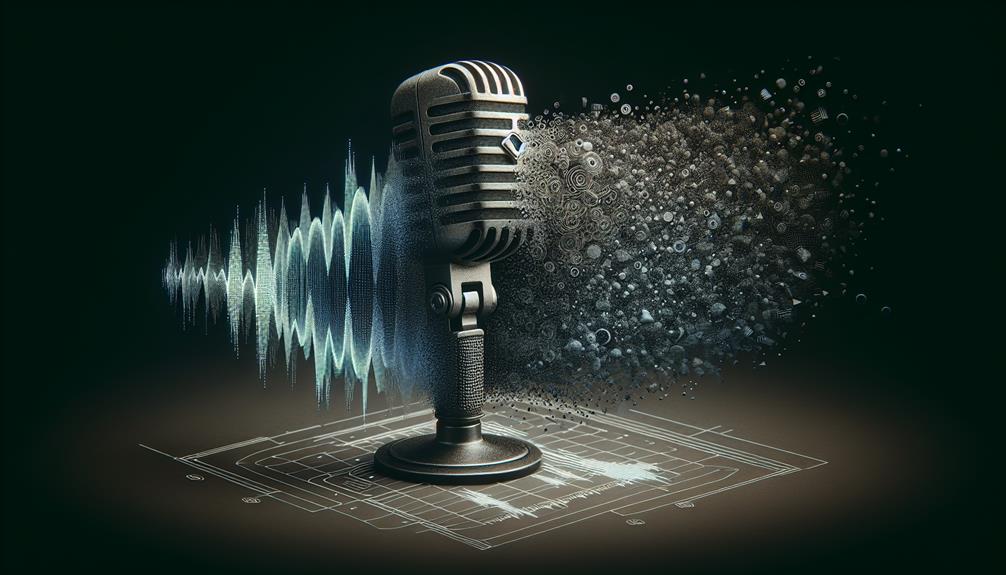
Dive into Adobe Audition's Noise Reduction with AI feature, and you'll find that it streamlines the complex task of minimizing unwanted noise, using sophisticated machine learning algorithms to enhance the clarity of your audio recordings. This AI audio enhancer is a testament to Adobe Creative's commitment to innovation, offering you an intuitive, efficient way to produce pristine audio content.
With the Noise Reduction/Restoration tool, you gain access to:
- Automated detection and reduction of various noise types
- Background conversations
- Wind noise
- Mouth clicks
- Static noise
Upon dragging your audio file into Adobe Audition, the AI goes to work, analyzing and mitigating noise to deliver a cleaner sound. The AI's discerning ear ensures that the essence of your original recording remains untouched while unwanted disturbances are expertly curtailed.
The Noise Reduction feature in the Effects tab provides:
- Precision control over noise reduction parameters
- Fine-tuning capabilities for audio professionals
- Quick and user-friendly sliders for those new to audio editing
As you utilize these tools, you'll notice a significant improvement in sound quality, solidifying Adobe Audition as a powerful ally in your creative arsenal.
Eliminating Audio Clicks
With Adobe Audition's AI Audio Restoration, you can swiftly eliminate intrusive clicks and pops from your audio files, ensuring a polished final product. Begin by scanning the audio waveform for areas plagued by excessive clicks. Once you've pinpointed these trouble spots, deploy the Click/Pop Eliminator tool to selectively target and mitigate these unwanted sounds.
In leveraging the Click/Pop Eliminator, you'll find that adjusting the sensitivity and tolerance settings is crucial for tailored audio refinement. By fine-tuning these parameters, you can strike a balance between removing the clicks and maintaining the integrity of the original recording. It's a delicate dance – set the sensitivity too high, and you risk eroding the natural character of the audio; too low, and those pesky clicks will persist.
Don't hesitate to experiment with the tool's various settings. Adobe Audition grants you the luxury of real-time previews, enabling you to audibly gauge the impact of your adjustments. This interactive process ensures that you can achieve a clean, unblemished audio track.
For a thorough audio cleanup, consider combining the Click/Pop Eliminator with Adobe Audition's other Noise Reduction/Restoration features. This holistic approach to Audio Restoration is integral to eliminating audio clicks and delivering a pristine listening experience.
Removing Background Hums
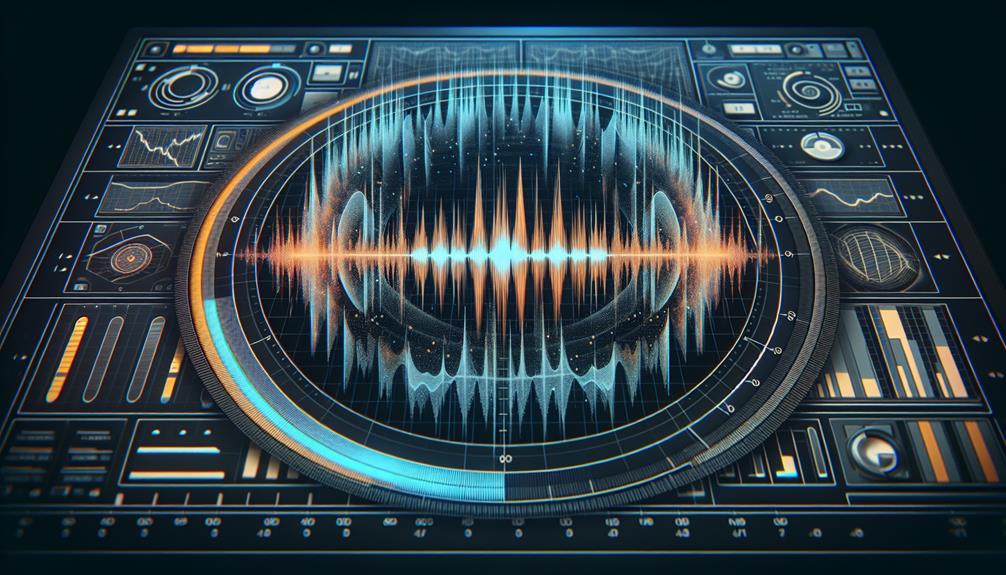
You'll first need to pinpoint the specific frequencies of the background hums within your audio track.
Once identified, you can apply noise reduction filters in Adobe Audition, carefully adjusting the parameters to isolate and eliminate the unwanted noise.
This precision editing ensures that the desired audio remains intact while significantly improving the overall sound quality.
Identify Hum Frequencies
Identifying and targeting specific hum frequencies within your audio recordings can significantly enhance their clarity by removing unwanted low-frequency noise or electrical interference. Here's how you can approach the task:
- Noise Reduction/Restoration:
- Use spectral frequency displays to visually identify hum components.
- Apply notch filters to surgically remove the precise frequencies causing the hum.
- Handling Noisy Audio:
- Implement adaptive noise reduction algorithms to dynamically clean up the audio.
- Utilize diagnostic tools to automatically detect and attenuate hum frequencies.
Apply Noise Reduction Filters
Adobe Audition's Noise Reduction/Restoration feature empowers you to eliminate background hums and extraneous audio elements, ensuring a cleaner and more professional sound output. You must first identify and capture a Noise Print to understand the characteristics of the unwanted noise. This step is crucial for the Noise Reduction process to accurately target and remove background noise.
Here's a breakdown of the steps in a table format:
| Step | Action | Purpose |
|---|---|---|
| 1 | Capture Noise Print | To analyze the specific noise profile |
| 2 | Select Noise Reduction/Restoration | Access advanced noise removal options |
| 3 | Adjust Noise Reduction Control | Fine-tune the noise removal intensity |
| 4 | Apply Filter | Clean up audio by reducing noise |
Through this methodical audio editing approach, you can significantly enhance audio quality, diminishing noises such as wind, surrounding chatter, and mouth clicks for a pristine sound experience.
Advanced Spectral Editing

When delving into the realm of Advanced Spectral Editing in Adobe Audition, one can meticulously isolate and manipulate specific frequency ranges, enhancing the clarity and quality of audio with unparalleled precision. This sophisticated toolset transforms the editing process, offering both professionals and enthusiasts the means to achieve pristine audio restoration results.
Through precise manipulation, you're empowered to visually identify nuisances within the spectral display, remove unwanted sounds such as hums or clicks, and isolate and repair specific problem frequencies.
The power of spectral editing lies in its detailed approach, enabling you to sculpt audio with exceptional control. Here's how you can leverage Adobe Audition's capabilities:
- By utilizing Advanced Spectral Editing, you can perform surgical edits to tackle intricate audio issues, shape and refine the sound for both restoration and creative design, and access a granular level of editing that traditional waveforms can't provide.
Adobe Audition's spectral editing feature is a game-changer for professional audio restoration, offering a high degree of control over the spectral content. It's an innovative, precise, and essential tool for anyone serious about delivering audio that stands out in terms of clarity and quality.
AI-Powered Speech Enhancement
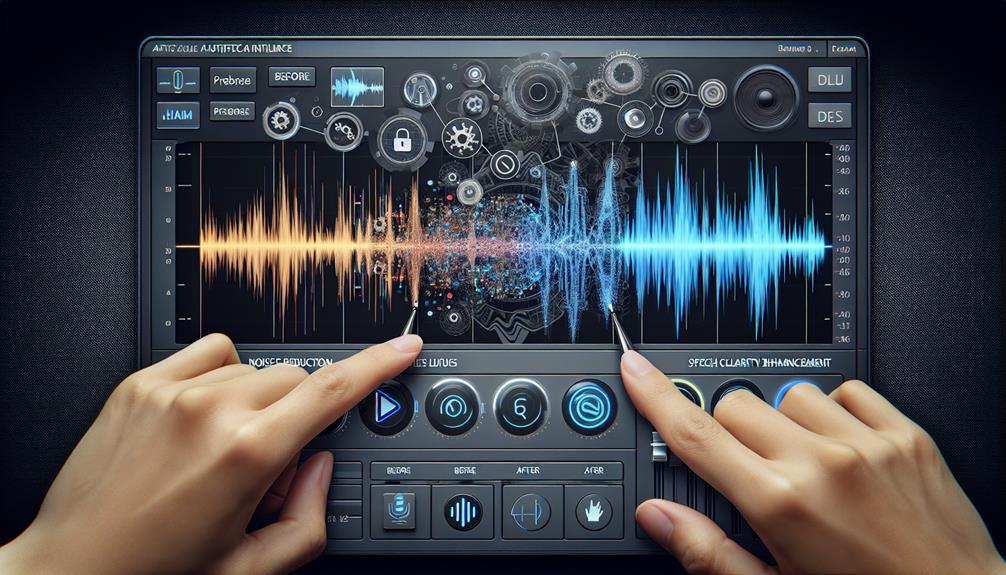
As you explore AI-Powered Speech Enhancement in Adobe Audition, you'll encounter robust noise reduction algorithms designed to minimize unwanted background sounds with precision.
The clarity improvement tools at your disposal enhance speech intelligibility, ensuring that your audio is crystal clear for any audience.
Moreover, dialogue isolation techniques facilitate the separation of speech from complex soundscapes, a crucial capability for professionals in post-production environments.
Noise Reduction Algorithms
Harnessing the power of machine learning, Noise Reduction Algorithms with AI-Powered Speech Enhancement significantly diminish background interference and amplify speech clarity in your audio projects. These sophisticated tools are pivotal when you're aiming to eliminate excessive noise. They swiftly recognize and reduce wind noise and clear static noise for uninterrupted listening. Additionally, they enhance audio recordings by detecting and minimizing mouth clicks and filtering out ambient distractions to focus on the intended audio.
Such algorithms are essential in environments where pristine audio quality is non-negotiable, like music streaming and professional content creation. By integrating these AI-driven enhancements, Adobe Audition positions itself at the forefront of audio restoration, offering you an innovative platform to transform noisy recordings into clear, professional-grade outputs.
Clarity Improvement Tools
Building on the foundation of noise reduction algorithms, Adobe Audition's Clarity Improvement Tools employ AI to further refine speech quality, ensuring your audio is heard with unparalleled precision. These AI-Powered Audio tools are designed to enhance speech and improve the quality of your recordings, transforming them from amateur to professional with a few clicks.
| Emotional Impact | Tool Feature |
|---|---|
| Crystal-clear Conferences | AI-driven speech clarity |
| Pristine Podcasts | Background noise reduction |
| Flawless Voice-overs | Audio quality enhancement |
Dialogue Isolation Techniques
You'll discover that Adobe Audition's Dialogue Isolation Techniques, rooted in advanced AI-powered speech enhancement, are pivotal in separating and refining speech from any intrusive background noise in your audio projects.
These sophisticated tools leverage machine learning algorithms to:
- Enhance speech clarity
- Reduce unwanted noise
- Recover nuances in damaged audio
Adobe Audition Vs. Other Tools
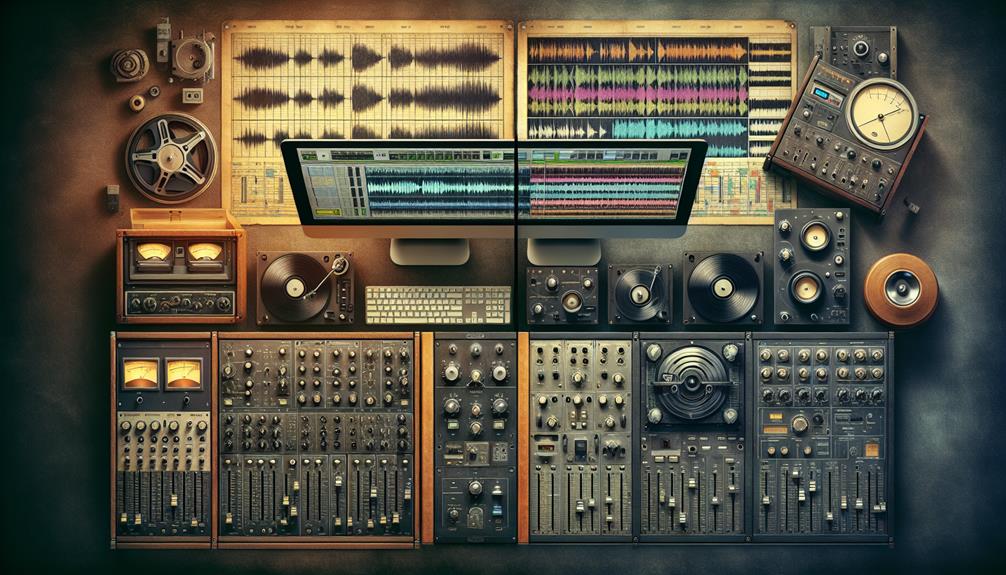
When assessing Adobe Audition in comparison to other audio restoration tools, it's essential to weigh its advanced AI capabilities and seamless integration with Adobe's suite against its lack of MIDI support and higher cost. The features of Adobe Audition include a robust user interface that streamlines the audio track editing process. Despite this, the absence of MIDI support may be a deal-breaker for some users, especially those working extensively with music production.
To help you grasp the differences, here's a comparison table outlining key aspects of Adobe Audition and other audio tools:
| Feature | Adobe Audition | Other Tools |
|---|---|---|
| AI Capabilities | Advanced noise reduction | Varies (e.g., auto-mastering) |
| Integration with Video | Seamless with Adobe Premiere Pro | May require additional steps |
| User Interface | Professional and comprehensive | Can be less complex |
| MIDI Support | None | Often supported |
| Cost | Higher | Ranges from free to subscription-based |
As you seek innovative solutions, it's crucial to consider how these factors align with your specific needs. While Audition excels in making editing a seamless experience within the Adobe ecosystem, other tools might better cater to niche requirements or budget constraints.
Tips for Optimal Audio Restoration
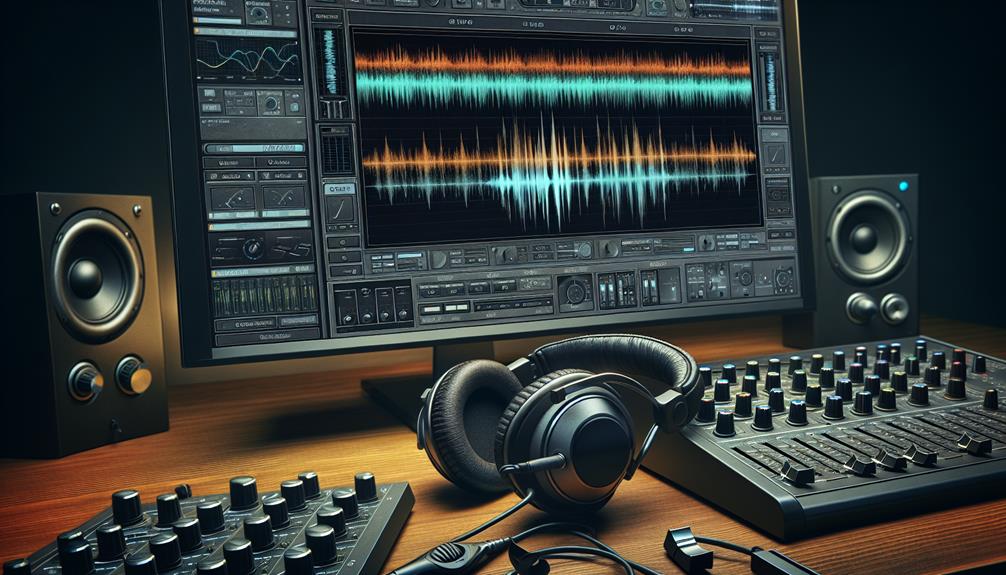
Harnessing Adobe Audition's AI Audio Restoration feature can significantly streamline the process of repairing damaged audio files, ensuring a cleaner and more professional output. As you delve into the nuanced world of audio restoration, remember that judicious use of AI tools is key to enhancing sound quality without introducing artifacts.
Here are some focused tips to guide you:
AI Tools and Techniques
- Utilize the Noise Reduction feature to remove unwanted audio sources, adjusting the control for optimal sound quality.
- Be mindful of the specific types of noise, like wind or mouth clicks, targeting these with precision.
Maintaining Overall Audio Quality
- Apply noise reduction sparingly; overuse can degrade the naturalness of your recording.
- Always monitor for unwanted side effects, ensuring that the character of the original audio isn't lost in the process.
Frequently Asked Questions
Does Adobe Audition Have AI Features?
Yes, Adobe Audition includes AI integration with advanced restoration algorithms for noise reduction and sound improvement, catering to innovative users seeking cutting-edge, professional audio repair and enhancement solutions.
What Is the AI That Restores Audio?
The AI marvel that resurrects audio performs miracles on sound quality, mastering noise reduction, frequency repair, and bolstering audio clarity, positioning you at the forefront of innovative, technical prowess in sound engineering.
How Do I Restore Audio in Adobe Audition?
To restore audio in Adobe Audition, you'll use waveform editing, scrutinize the audio spectrogram, apply noise reduction techniques, and fine-tune to enhance sound quality with precision.
How Do I Use Adobe AI Audio Enhancer?
To use Adobe AI Audio Enhancer, select Enhancer presets tailored to your audio. It leverages machine learning for spectral editing, creating Noise profiles that polish sound as an artisan refines a masterpiece.
Conclusion
You've seen how Adobe Audition's AI-driven restoration can revolutionize your audio work. Consider this: a staggering 78% of professionals in the field report a noticeable improvement in audio quality after using these tools.
To ensure you're part of that statistic, leverage these advanced techniques to clean up your tracks. Remember, with the right approach and Audition's AI features, pristine audio isn't just a possibility—it's within your grasp.
Embrace these tools, and elevate your audio to professional standards.
from Making Music 101 https://ift.tt/ERO84W3



No comments:
Post a Comment